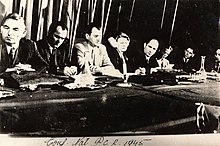Florica Bagdasar
Florica Bagdasar (née Ciumetti) (January 24, 1901 – December 19, 1978) was a Romanian neuropsychiatrist, who was the first woman minister in Romania at the Ministry of Health between 1946 and 1948.
The newly-weds Bagdasars went to Boston, Massachusetts to pursue professional training; Florica to attend Public Health courses at Harvard University, and Dumitru to acquire knowledge about the new neurosurgery techniques from the pioneer of modern brain surgery, Dr. Harvey Cushing, at his clinic, Peter Bent Brigham.
Upon their return to their country in 1929, the couple spent a few years in Jimbolia and Cernăuți (Hospital for Nervous Diseases), after which they arrived in Bucharest, where they settled and where remained until the end of their lives.
Bagdasar and her collaborator, Florica Nicolescu (Stafiescu), have successfully developed and experienced in numerous primary schools their own alphabet textbook ("The Book for All Children") and their own arithmetic manual, both based on the global grouping idea and simplified vertical writing.
As director of this institution, Florica Bagdasar recruited and organized an exemplary team of experts to deal with children's problems, psychologists, pedagogues, speech therapists, and kinesiotherapists.
In the years immediately following World War II, both Bagdasar ministers of health, her husband first, then she, faced serious crises that urgently needed to be resolved: sanitary networks decimated by the war, poverty, terrible famine – especially in the region of Moldavia where drought and fierce winter had ravaged — and which in turn contributed to the devastating epidemics of endemic typhus in Moldavia and malaria in Dobruja.
[10][11] Paul Cortez,[12] the well-known Romanian psychiatrist, and epidemiologist Mihai Ciucă worked directly with the Minister of Health - Florica Bagdasar - in campaigns to combat these epidemics.
[8][13] In 1949, Bagdasar was appointed associate professor at the Medical-Pharmaceutical Institute (IMF) in Bucharest, where she introduced the specialty of pediatric neuropsychiatry (Normal and Pathological Child Psychology).
The fact that in 1949 she was appointed as associate professor at the Bucharest Medical and Pharmaceutical Institute and in October 1957 the vice-president of the Red Cross organization in Romania could suggest that Florica Bagdasar had a career of uninterrupted ascension.
[21] Immediately after the article appeared, an official delegation descended at the Mental Hygiene Center and Bagdasar was removed from the position of director and forced to hand over the files and keys of the institute on the spot.
The complete article in Scînteia was accusing Bagdasar of "cosmopolitanism", of sluggish plunder in front of the rotten bourgeois ideology, of perversion of infantile psychiatry by introducing Freud-like obscurantist approaches, etc.
She was left with no income, because her husband's pension from the academy was stopped, and the Housing Department (Spațiul Locativ) forced her to share with another family with two children the apartment where she lived with her daughter.
[1][2][6][8][3] At the end of 1956, the wave of Stalinist terror had passed over, and Bagdasar began to be "rehabilitated" (along with the de-Stalinization program initiated by Nikita Khrushchev in the Soviet Union).
She continued to live in Romania until the end of her days in 1978, being treated by the government in a "quasi-particular" way as Valeriu Negru's states in an article: "she was tolerated politically, but not liked.

